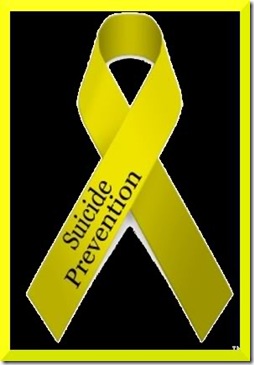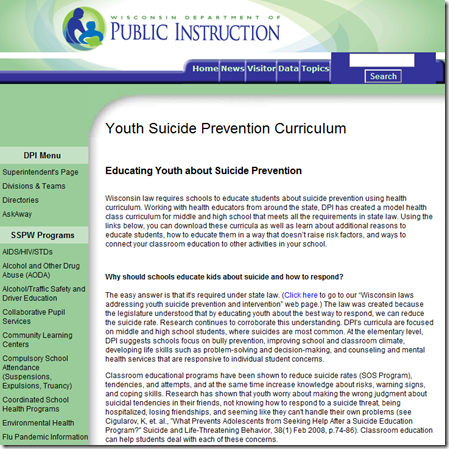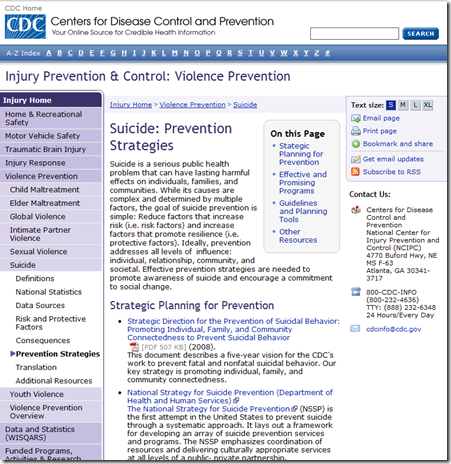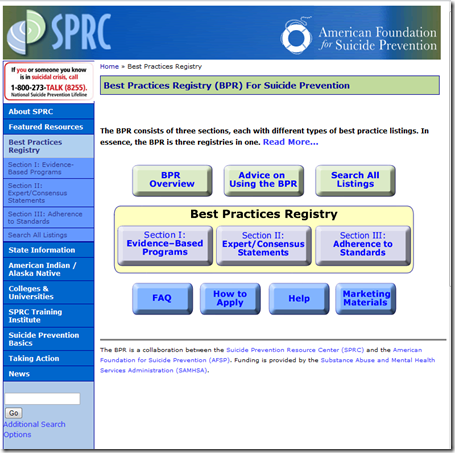Preventing Teen Suicide
Sunday, December 5, 2010
Recommendation: A National Curriculum
Currently, teen suicide prevention resources are fragmented. There are numerous programs with varying levels of resources and commitment. We feel that a national strategy might present an effective, concerted, and cost effective means to help prevent teen suicide.
The State of Wisconsin has a well-developed curriculum that can serve as a model for further development. The curriculum includes programs for Grades 6-8 and 8-10.
Contents of the program include materials to help educators:
- Develop awareness of student issues.
- Systematically deliver the knowledge and skills presented in the curriculum
- Develop parental support and awareness
- Address cultural differences in development of depression and/or suicidal behaviors
- Understand suicide risk and related substance abuse risks
- Develop teams and community approaches to address and identify issues
The Wisconsin program can be reviewed at http://dpi.state.wi.us/sspw/suicideprevcurriculum.html
Friday, December 3, 2010
Brief History of Suicide Prevention
1958: Los Angeles Suicide Prevention Center opens, funded by the U.S. Public Health Service and directed by Edwin Shneidman.
1966: Center for the Study of Suicide Prevention (later renamed the Suicide Prevention Research Unit) established at the National Institute of Mental Health.
1968: American Association of Suicidology founded by Edwin Shneidman.
1983: CDC Violence Prevention Unit (later subsumed into the National Center for Injury Prevention and Control) established; focuses public attention on an increase in the rate of youth suicide.
1985: Secretary's Task Force on Youth Suicide established to review the problem of youth suicide and recommend actions.
1987: American Foundation for Suicide Prevention founded.
1989: Report of the Secretary's Task Force on Youth Suicide published by the U.S. Department of Health and Human Services.
1996: Prevention Action Network (SPAN) USA founded with the goal of preventing suicide through public education, community action, and advocacy.
1996: Prevention of Suicide: Guidelines for the Formulation and Implementation of National Strategies published by the World Health Organization and the United Nations, with the participation of a number of agencies within the U.S. Department of Health and Human Services.
1998: National Suicide Prevention Conference held in Reno, Nevada as a response to the WHO/UN publication. This public/private partnership created an expert panel that issued 81 recommendations.
1999: Surgeon General's Call to Action to Prevent Suicide published, which consolidated the National Suicide Prevention Conference's recommendations, including the creation of a National Strategy for Suicide Prevention.
2001: National Strategy for Suicide Prevention published by the U.S. Department of Health and Human Services. It outlined a coherent national plan to enhance the suicide prevention infrastructure, including the creation of a technical assistance and resource center.
2002: Suicide Prevention Resource Center established at Education Development Center, Inc. with funding from the Substance Abuse and Mental Health Services Administration.
2002: Reducing Suicide: A National Imperative published by the Institute of Medicine of the National Academies of Science. This publication examined and summarized the state of knowledge about suicide and the state of the art of suicide prevention.
2003: Achieving the Promise: Transforming Mental Health Care in America published by the President's New Freedom Commission on Mental Health.
2004: Garrett Lee Smith Memorial Act passed by the U.S. Congress to support and enhance youth suicide prevention efforts in the states, among tribal nations and at colleges and universities.
2004: National Suicide Prevention Lifeline (1-800-273-TALK) funded by the Substance Abuse and Mental Health Services Administration, U.S. Department of Health and Human Services.
2005: The Department of Labor, Heath and Human Services, and Education, and Related Agencies Appropriations Act of 2006 which appropriates a total of $30 million for suicide prevention was signed into law.
2006: The SAMHSA Program Priority Matrix was updated to include suicide prevention as one of the matrix priorities.
2006: Federal Working Group on Suicide Prevention established. Representatives from SAMHSA, Centers for Disease Control, National Institute on Mental Health, Indian Health Services, Department of Defense, Veterans Affairs and other federal agencies.
Guidelines for School Based Suicide Prevention Programs
Program Description
Developed by the Prevention Division of the American Association of Suicidology, the Guidelines for School-Based Suicide Prevention Programs provides practical recommendations for the safe and effective
implementation of school-based suicide prevention programs. Topics addressed by the Guidelines include:
- The conceptual basis for prevention programs
- Requirements for effective suicide prevention programs
- Requirements for effective program implementation
- Requirements for institutionalization and sustainability of suicide prevention programs
- Components of comprehensive school-based suicide prevention programs
Program Objectives
Users of the Guidelines should have:
1. Increased knowledge of the conceptual and theoretical underpinnings of effective school-based suicide
prevention programs.
2. Increased understanding of universal, selective, and indicated approaches to suicide prevention.
3. Increased knowledge of effective program implementation and sustainability strategies.
4. Increased knowledge of the multiple components of a comprehensive school-based suicide prevention
program.
Program Development
The Guidelines were developed by members of the Prevention Division of the American Association of Suicidology in 1999. Content was derived from both a review of the literature and expert opinion. Significant input
was provided by John Kalafat of Rutgers University.
School Based Suicide Prevention Programs and Useful Materials
Columbia University TeenScreen® Program helps schools and communities implement screening programs to identify at-risk teens and pre-teens. It uses simple screening tools that can detect depression, the risk of suicide, and other mental disorders in teens to help schools identify and arrange treatment for youth who are suffering from depression and other undiagnosed mental illness and those who are at risk of suicide.
Jason Foundation, Inc. educates young people, parents, teachers, and others who work with young people about youth suicide. The foundation offers programs, seminars, and support materials on suicide awareness and prevention.
SOS Signs of Suicide® Program provides school health professionals with the educational materials necessary to replicate this program, which teaches high school students to recognize the signs and symptoms of suicide and depression in themselves and others and to follow specific action steps to respond to those signs. The program can be incorporated into an existing health curriculum or can be used as a stand-alone program. The program includes educational materials, a training video, and an implementation manual, and can be completed in one or two class periods.
The Main Youth Suicide Prevention Program recommends components that schools should implement as part of a broad-based prevention program.
The Youth Suicide Prevention School-Based Guide was developed by the Florida Mental Health Institute at the University of South Florida. It provides a framework for schools to assess their existing or proposed suicide prevention efforts (through a series of checklists) and provides resources and information that school administrators can use to enhance or add to their existing program. Information is offered in a series of issue briefs corresponding to a specific checklist. Each brief offers a rationale for the importance of the specific topic together with a brief overview of the key points. The briefs also offer specific strategies that have proven to work in reducing the incidence of suicide, with references that schools can use to explore these issues in greater detail.
These resources can be immensely helpful to teachers and other school officials. However, if the programs are not followed and carried out meticulously, failure could be the result.
For more information on the guidelines of such programs as set by the American Association of Suicidology see the section titled “Guidelines for School Based Suicide Prevention Programs”
Did You Know?
- Every year there are approximately 10 youth suicides for every 100,000 youth
- Each day there are approximately 11.3 teen suicides
- Every 2 hours and 7 minutes, a person under the age of 25 commits suicide
- For every completed youth suicide it is estimated that 100-200 attempts are made
- In a typical high school classroom it is estimated that at least 3 students have made a suicide attempt within the past year
Did you know that the California education code section 41533 states:
“This statute authorizes school districts to use a portion of their Professional Development Block Grant funding to pay for suicide prevention training for school teachers. The teacher training is not to exceed two hours and may occur during a regularly scheduled in-service day"
This seems troubling because we can't expect teachers to learn everything there is to know about suicide prevention and all of its different components if the funding will only "allow" them to have ONLY 2 hours or less in training.
Wednesday, December 1, 2010
Online Resources for Educators
There are a variety of online resources available to help educators establish suicide prevention and intervention programs in their schools.
Wisconsin Department of Public Instruction – Youth Suicide Prevention Curriculum
Provides downloadable curricula aimed at directly addressing youth suicide prevention.
http://dpi.state.wi.us/sspw/suicideprevcurriculum.html
Centers for Disease Control (CDC) Suicide Prevention Strategies
This site is part of the Centers for Disease Control and Prevention and offers national strategic planning for prevention of suicide. The site provides a wealth of current information and evaluates effective strategies.
http://www.cdc.gov/ViolencePrevention/suicide/prevention.html
The American Foundation for Suicide Prevention (SPRC)
Provides a National resource for Best Practices in suicide prevention and intervention strategies.





